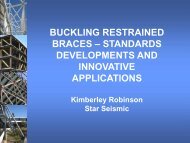Environmental Impacts of Multi-Storey Buildings Using Different ...
Environmental Impacts of Multi-Storey Buildings Using Different ...
Environmental Impacts of Multi-Storey Buildings Using Different ...
Create successful ePaper yourself
Turn your PDF publications into a flip-book with our unique Google optimized e-Paper software.
- 54 -6.3 Life Cycle Assessment <strong>of</strong> the Four Building Designs6.3.1 GoalThe goal <strong>of</strong> this study is to calculate the environmental impacts (energy consumption andGlobal Warming Potential) <strong>of</strong> four alternative designs <strong>of</strong> a theoretical <strong>of</strong>fice building locatedon the University <strong>of</strong> Canterbury campus.The four designs are composed <strong>of</strong> three different structural materials; Concrete, Steel andTimber. In addition a variant called TimberPlus has been examined, in which the use <strong>of</strong> woodhas been maximised to the highest practical level.The study includes the initial production <strong>of</strong> the required materials to construct the building, amaintenance schedule where some building materials are replaced over the lifetime <strong>of</strong> thebuilding, impacts related to the operational energy, and the end-<strong>of</strong>-life <strong>of</strong> the four buildings.In addition to the overall goal, scenario analysis and sensitivity tests were carried out. Thescenario analysis examined different end-<strong>of</strong>-life scenarios, as well as the impact <strong>of</strong> differentlocations <strong>of</strong> the buildings with regard to changes in transport distances.The end-<strong>of</strong>-life scenarios include a base scenario where all waste is landfilled compared witha scenario in which the building materials are reused. This includes combustion <strong>of</strong> all woodmaterials and recycling <strong>of</strong> structural concrete and steel. Scenarios for transport distances lookat the location <strong>of</strong> the building in Christchurch (base scenario), Wellington, and Auckland.The end-<strong>of</strong>-life and transport scenarios are described in more detail in sections 6.3.3.3 and6.3.3.4.Finally, the results <strong>of</strong> the study are analysed and compared with an assessment <strong>of</strong> thebuildings using the current Green Star NZ assessment tool introduced by the New ZealandGreen Building Council (NZGBC). Green Star NZ is an environmental rating system forbuildings. Green Star for <strong>of</strong>fice buildings was released in April 2007 and evaluates buildingprojects against eight environmental impact categories, plus innovation. The goal <strong>of</strong> thisanalysis is to show how the same commercial building would rate using Green Star comparedto a life cycle based approach, as it is applied in Life Cycle Assessment.6.3.2 ScopeThe scope <strong>of</strong> the study includes a clear description <strong>of</strong> the system under analysis, thefunctional unit, system boundaries and data quality as well as the intended audience andapplication <strong>of</strong> the results.6.3.2.1 Functional UnitThe results <strong>of</strong> the study are related to an <strong>of</strong>fice building with gross area 4,247 m 2 on sixfloors, located in Christchurch and used over a period <strong>of</strong> 60 years. Four designs <strong>of</strong> thebuilding have been considered.
















